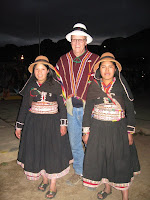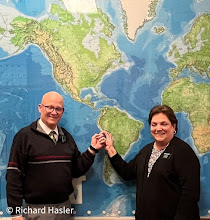Anniversary in Lahuani… Carbon Monoxide Dancing
 Characteristic, native dress in Peru is a pretty constant factor. I am in a remote part of Peru called Apurimac where not much has changed in the way people dress in hundreds of years. They also speak Quechua, I am sure I have made mention of this in the past. Some of the names of clothing are recognizable quechuizations of the original Spanish like; chilico from chaleco for jacket, but many are original Quechua terms.
Characteristic, native dress in Peru is a pretty constant factor. I am in a remote part of Peru called Apurimac where not much has changed in the way people dress in hundreds of years. They also speak Quechua, I am sure I have made mention of this in the past. Some of the names of clothing are recognizable quechuizations of the original Spanish like; chilico from chaleco for jacket, but many are original Quechua terms.Here, the men wear a sort of home spun outfit of reversible beige and black pedal pusher/Capri length pants called wara, a light internal long john called fundillo (fundil-yo) and a shirt, arnilla (arneel-ya), of the same material as the pants. The pants also button at the bottom. They wear a sort of a black waistcoat with bright colored, decorative buttons, some functional others just as adornment in the front and at the cuffs called a chilico (Cheell-eeko). The more brightly colored and abundant buttons are used by the courting aged men. They sometimes wear tennis shoes, boots or oxfords but have traditionally worn ojotas (o-hotas) (rubber tire sandals). They wear an ornately crocheted cap a chullo (Chool-yo) with an ornate tassel called a huaytilla (waytee-l-ya). I have taken to wearing one of these to keep my bald head warm. They top the cap with a bell shaped hat, adorned with black girly ribbons sewed in place with red thread. The colors never vary. The caps of available men young have more ornate tassels including a little tiny cap in the tassel, meaning that they are looking for someone with whom to fill the little baby hat. They also wear an ornately woven belt called a chumpi (Choo-mpee) Both men and women wear this but those of the women are much wider than what the men wear. Over the jacket, they tie a woven huaraca (waraca) or sling, indicating readiness to defend their honor. The men also wear a rolled up poncho around their waist unless it is raining when they wear it as a poncho and if it is cold they wear a scarf around their neck.

The women dress in a black home spun woolen dresses polleras (pol-yeras) with a red woolen blouse underneath called an almilla (almeel-ya). They wear red skirts if they are single but this is not so rigorous. The dress consists of a wrap around skirt with at least three layers and the border is embroidered along the base of the skirt. The top is a jacket like the men’s embroidered at the cuffs with more colorful buttons than the men use and is called a jubon (hubon). They wear the chumpi too in a way that shows it off more than the men because they want to show off their fine weaving. Women rarely wear shoes other than ojotas, usually with a little plastic flower on the straps, and often go barefoot but not to fiestas. They wear a llicllia (lyeeck-lyee-ya) that would hold a baby if they have one but they all wear it slung over their shoulders and tied in front. Instead of a cap, they place a woven black, rectangular cloth with an embroidered edge called a huayticllia (way-tic-leeya) o phullu (ful-yu) on their head under their bell shaped hat. The hats can be white or brown in either case.
 When I asked one of our young workers to make me an outfit, she blushed and said she could not, that it was not permitted and that men make clothes for men and women for women, some sort of a taboo related to this. Anyway, even men crochet, braid and spin wool continually, something not really common around Peru. But I have probably mentioned that before.
When I asked one of our young workers to make me an outfit, she blushed and said she could not, that it was not permitted and that men make clothes for men and women for women, some sort of a taboo related to this. Anyway, even men crochet, braid and spin wool continually, something not really common around Peru. But I have probably mentioned that before.I had an invitation to a community anniversary get together in one of our communities called Lahuani. The poorest of the communities in which we work, Lahuani boasts about 40 families. We provided all of their prizes for their sporting activities and rather than the cash that they had requested we gave them rice, sugar and noodles that they could divvy up for each of the prizes. They felt good about that. We also loaned them an electrical generator that they had requested. It turned out that they also wanted us to provide music and we could not meet that.
 When we arrived at the party, rain fell steadily and they had decided to hold the activity in the big school room. They crammed all of the community that could fit in the building dressed to the nines. They had brought in a TV and DVD and had gathered around to watch Peruvian comedy sketches. The fumes from the generator wafted into the room until I moved the generator but they seemed not to notice either way. They finally got around to dancing and, while not a very gregarious group considering other Peruvian bashes I have attended, they danced with great reserve despite the music. The girls did not want to dance with the gringo and acted very timid but did so nonetheless. This is kind of an expected part of the whole activity.
When we arrived at the party, rain fell steadily and they had decided to hold the activity in the big school room. They crammed all of the community that could fit in the building dressed to the nines. They had brought in a TV and DVD and had gathered around to watch Peruvian comedy sketches. The fumes from the generator wafted into the room until I moved the generator but they seemed not to notice either way. They finally got around to dancing and, while not a very gregarious group considering other Peruvian bashes I have attended, they danced with great reserve despite the music. The girls did not want to dance with the gringo and acted very timid but did so nonetheless. This is kind of an expected part of the whole activity.
In the end, glad I moved the generator because I still got a headache from it, I could not help reflecting on the whole image of the eerie blue TV light and the music videos and dancing amid all of the traditionally dressed people. It seemed positively surreal, once again…


0 Comments:
Post a Comment
<< Home